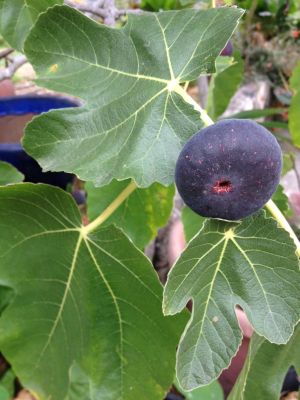Semi-dwarf trees like “Black Jack” fig trees (Ficus carica “Black Jack”), in USDA plant hardiness zones 7 through 9, reach up to 15 feet, but they produce well when kept at 6 feet tall.

Related Articles
- 1 Facts on Satsumas
- 2 Cherry Tree Tips
- 3 Tell When a Fig Is Ripe Enough to Pick?
- 4 Summer-Blooming Fruit Trees
Dwarf fig trees (Ficus carica) grow best in U.S. Department of Agriculture plant hardiness zones 8 through 11, even though figs will produce fruit in colder climates if grown with winter protection. Fig trees are considered borderline temperate fruit trees because they have a low chilling time of less than 300 hours of temperatures below 45 degrees Fahrenheit in order to bear fruit. Dwarf fig trees grow well in containers and in areas with limited space.
Where Do Dwarf Fig Trees Come From?
Fig trees originate from western Asia where hot, dry summers and cool, mild winters occur. By 5,000 B.C., this fruit tree was distributed throughout the Mediterranean area by traders. The fruit is common in the Middle East as well. Some wild varieties tend to grow slowly and stay short naturally. Plant hybridizers have taken advantage of this tendency and developed dwarf forms that still produce full-sized figs.
Black Jack Fig Tree Size
How Large Will My Dwarf Fig Get?
Fig trees grow to a variety of heights depending on the type. Many dwarf fig trees reach up to 10 feet tall and wide like the “Celestial” fig tree (Ficus carica “Celestial”). This dwarf fig grows well in USDA zones 7 through 11, producing small sweet figs, which ripen in the middle of June. Semi-dwarf trees like “Black Jack” fig trees (Ficus carica “Black Jack”), in USDA plant hardiness zones 7 through 9, reach up to 15 feet, but they produce well when kept at 6 feet tall by annual pruning. Standard trees like “Brown Turkey” fig trees (Ficus carica “Brown Turkey”) grow to 25 feet tall and wide in USDA zones 7 through 9.
Do I Need to Prune My Dwarf Fig Tree?
Dwarf fig trees require pruning only when they are young and need shaping. Take only a little of the growth off a few of the branches each year until the tree is the desired shape. Heavy pruning contributes to fruit loss since figs develop on last year’s growth. If heavy pruning is needed, cut only half the branches the first summer and trim the other half of the branches the next summer. Always whitewash the tree if severely pruned. This prevents damage from exposure from the hot summer sun. After the first crop of figs of the year, remove dead and broken branches.
When Do I Pick Figs From My Dwarf Fig Tree?
Several varieties of dwarf fig trees produce two crops of figs a year. The spring crop matures anywhere from late spring to mid-summer. The second, or main crop, ripens in the late summer or early fall. Look for fruits that are beginning to bend at the neck and whose skin is slightly soft to the touch. Many varieties change color and develop cracks in the skin when ripe. Do not pick the figs when they are still immature. Figs do not ripen after picking like tomatoes do. Fresh figs keep only two to three days in the refrigerator, while dried figs store up to eight months.
References (6)
About the Author
Black Jack Fig Tree Care
Karen Carter spent three years as a technology specialist in the public school system and her writing has appeared in the 'Willapa Harbor Herald' and the 'Rogue College Byline.' She has an Associate of Arts from Rogue Community College with a certificate in computer information systems.
Cite this Article